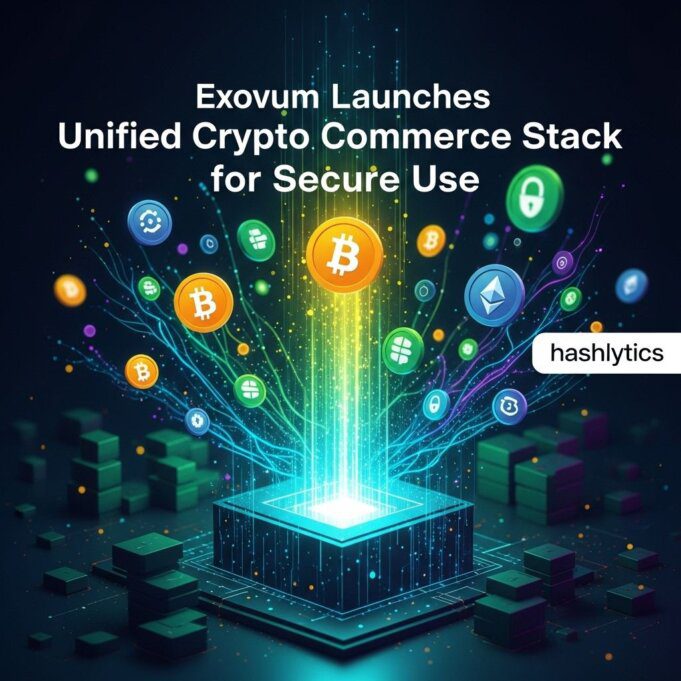The Four-Component Architecture
Exovum’s platform consists of four integrated components designed to address different aspects of crypto commerce:
| Component | Function | Target Users |
|---|---|---|
| Exovum Wallet | Self-custodial storage, on-chain transfers, token management | Individual crypto holders |
| Exovum Pay | Merchant payment processing with clear settlement flows | Businesses accepting crypto payments |
| Exovum Rewards | On-chain participation mechanism for loyalty programs | Businesses seeking interoperable rewards |
| Exovum Card | Physical/virtual card for spending crypto at point-of-sale | Consumers wanting traditional payment UX |
Exovum Wallet: Self-Custodial Foundation
The Exovum Wallet consolidates core self-custody operations—asset storage, transfers, and token management—in what the company describes as a “structured interface” designed to present essential actions without unnecessary complexity.
Design Principles
- Contextual Guidance: Interface provides relevant information at decision points
- Consistent Hierarchy: Information architecture remains predictable across actions
- Explicit Confirmations: Transaction details presented clearly before execution
- Transparent Records: Post-transaction history with itemized details
For context on digital wallet architecture and their role in crypto ecosystems, see Investopedia’s digital wallet overview.
Competitive Context: The Crowded Wallet Market
Exovum enters a mature and competitive self-custody wallet space. According to a 2025 Gemini survey, 24% of adults across six major markets now hold cryptocurrency—up from 21% in 2024. Active stablecoin wallets jumped 53% year-over-year, from 19.6 million in February 2024 to 30 million by February 2025.
Established competitors include:
- Exodus: Multi-chain wallet supporting 50+ blockchains, 6 million users, publicly traded (NYSE: EXOD)
- MetaMask: Ethereum-focused wallet with extensive dApp ecosystem integration
- Trust Wallet: Binance-backed wallet with 60+ blockchain support
- Coinbase Wallet: Self-custody option from established exchange
Exovum differentiates by integrating wallet functionality with merchant payment infrastructure and rewards programs—targeting the “commerce stack” rather than just asset storage.
Exovum Pay: Merchant Payment Layer
Exovum Pay provides merchant-oriented payment processing with straightforward integration options. The system aims to simplify checkout while maintaining transparency through explicit confirmation steps and itemized transaction details.
Merchant Integration Resources
Exovum is developing support programs for merchants and developers including:
- SDKs: Software development kits for platform integration
- API Documentation: Technical specifications for checkout integration
- Sandbox Environments: Testing infrastructure before production deployment
- Webhook Support: Real-time settlement status notifications
- Refund/Adjustment Management: Tools for handling transaction disputes
The payment layer addresses a persistent challenge in crypto commerce: settlement clarity. Traditional crypto payments often lack transparent status reporting and predictable timelines, creating operational friction for merchants. Exovum’s emphasis on “clear settlement flows” suggests focus on reducing this ambiguity.
Exovum Rewards: On-Chain Loyalty Programs
Exovum Rewards enables interoperable loyalty programs built on blockchain infrastructure. The system presents clear eligibility conditions and redemption logic designed to support predictable outcomes for both users and participating businesses.
Why On-Chain Rewards?
Traditional loyalty programs face several limitations that blockchain-based alternatives attempt to address:
| Traditional Loyalty | On-Chain Loyalty |
|---|---|
| Siloed to single merchant | Interoperable across participating merchants |
| Opaque point valuation | Transparent on-chain value |
| Limited transferability | Can be transferred/traded (if designed for it) |
| Centralized databases | Decentralized, verifiable ledger |
Challenges: On-chain rewards introduce complexity around tax implications, regulatory classification (are they securities?), and user education. Whether these theoretical advantages translate to practical adoption depends on execution and merchant participation.
Cross-Chain Infrastructure: Bridging Fragmentation
A significant challenge in crypto commerce is blockchain fragmentation—assets exist across dozens of incompatible networks (Ethereum, Solana, Polygon, Arbitrum, etc.). Exovum’s stated objective is creating seamless cross-chain value transfer with predictable costs and transparent status reporting.
Cross-Chain Technical Challenges
Cross-chain bridges face well-documented security and usability issues:
- Security Risks: Bridges are frequent targets for exploits; over $2 billion lost to bridge hacks in 2022-2023
- Cost Unpredictability: Gas fees vary dramatically across networks and congestion levels
- Transaction Times: Cross-chain transfers can take minutes to hours depending on finality requirements
- Failed Transactions: Complex multi-step processes can fail mid-execution, stranding funds
Exovum’s promise of “predictable costs” will be tested against these realities. For technical context on cross-chain technology, see CoinMarketCap’s bridge explainer.
Security Architecture: Layered Defense Model
Exovum emphasizes security as a foundational element across client and server components:
Security Measures
- Hardware-Backed Key Storage: Where device supports it, keys stored in secure hardware enclaves
- Encrypted Transport: TLS encryption by default for all network communications
- Third-Party Security Reviews: Routine external audits of codebase and infrastructure
- Change Management: Formal processes for code deployments and infrastructure modifications
- Dependency Tracking: Monitoring of third-party libraries for vulnerabilities
- Audit Trails: Verifiable logs of releases and infrastructure changes
While these measures represent industry best practices, security ultimately depends on implementation quality and ongoing vigilance. Self-custody wallets place responsibility on users for key management—a single point of failure that no amount of infrastructure security can fully mitigate.
Compliance Framework: KYC, AML, and Regional Adaptation
Exovum is establishing compliance processes aligned with KYC (Know Your Customer), AML (Anti-Money Laundering), and sanctions-screening standards “where required for specific services.” This language suggests tiered compliance based on service type and jurisdiction.
Compliance Strategy
- Region-Appropriate Terms: Customized legal agreements per jurisdiction
- Privacy Notices: Transparent data handling practices describing collection, use, retention
- Data Minimization: Commitment to collecting only necessary personal information
- Jurisdiction-Specific Rollout: Service availability published as regional approvals are secured
Self-Custody Advantage: Wallet functionality typically requires less compliance overhead than payment processing or fiat on-ramps. Exovum’s multi-component approach means different services will face different regulatory thresholds.
For context on KYC/AML requirements in crypto, see Elliptic’s compliance overview.
Competitive Positioning and Market Reality
Exovum faces significant competition across every component of its stack:
| Category | Exovum Offering | Established Competitors |
|---|---|---|
| Self-Custody Wallet | Exovum Wallet | Exodus (6M users), MetaMask, Trust Wallet, Coinbase Wallet |
| Merchant Payments | Exovum Pay | BitPay, Coinbase Commerce, BTCPay Server, OpenNode |
| Crypto Cards | Exovum Card | Crypto.com Card, Coinbase Card, Nexo Card, Exodus-Baanx Card |
| Loyalty/Rewards | Exovum Rewards | Various blockchain-based loyalty platforms (limited adoption) |
The Integration Thesis
Exovum’s competitive angle appears to be vertical integration: combining wallet, payments, rewards, and cards under one platform rather than forcing users to assemble separate services.
Potential advantages:
- Seamless UX across wallet-to-payment-to-card flow
- Single KYC process instead of multiple verifications
- Unified customer support and account management
- Cross-component data insights for businesses
Challenges:
- Building and maintaining four distinct product categories simultaneously
- Competing against specialized players in each vertical
- Achieving sufficient scale in merchant adoption and user base
- Navigating different regulatory requirements per component
Roadmap and Developer Support
Exovum’s stated roadmap includes:
- Incremental Feature Releases: Gradual rollout of functionality rather than big-bang launches
- Language Localization: Multi-language support for global market access
- Accessibility Enhancements: Features supporting users with disabilities
- Expanded Developer Support: Additional SDKs, documentation, and integration tools
- User Research: Ongoing feedback collection to inform product decisions
- Transparent Communication: Regular updates on development progress and security evaluations
Early technical resources outline integration patterns for checkout implementation, webhook-based settlement notifications, refund handling, and loyalty program logic.
Market Context: Crypto Commerce in 2025
Exovum launches into a crypto market environment characterized by several trends:
Favorable Tailwinds
- Growing Adoption: 24% adult crypto ownership across major markets (Gemini 2025)
- Stablecoin Growth: Active stablecoin wallets up 53% year-over-year
- Payment Use Cases: Shift from speculation to practical transactions
- Regulatory Clarity: Some jurisdictions establishing clearer crypto frameworks
Persistent Headwinds
- Volatility: Price fluctuations make crypto challenging for commerce
- User Experience Complexity: Self-custody remains intimidating for mainstream users
- Merchant Hesitation: Many businesses avoid crypto due to accounting and tax complexity
- Regulatory Uncertainty: Rules vary dramatically by jurisdiction and evolve unpredictably
- Security Concerns: High-profile hacks and scams erode consumer trust
Key Takeaways
What Exovum Promises:
- Unified stack integrating wallet, payments, rewards, and card functionality
- Self-custody architecture with hardware-backed key storage where available
- Merchant-friendly payment infrastructure with clear settlement flows
- Cross-chain value transfer with predictable costs (ambitious claim)
- Compliance-ready processes aligned with KYC/AML standards
What Success Requires:
- Merchant Adoption: Payment infrastructure is only valuable with businesses accepting it
- User Acquisition: Need critical mass in competitive wallet market
- Security Track Record: Must avoid breaches that destroy trust instantly
- Regulatory Navigation: Successfully securing approvals across jurisdictions
- Cross-Chain Reliability: Delivering on promise of seamless, predictable transfers
- Developer Ecosystem: Building community around integration tools


